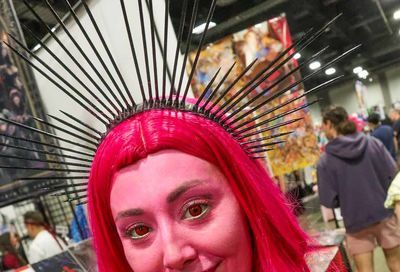Review: Super Mario Odyssey
Super Mario Odyssey is a vast, deep, beautiful game, and one of Mario’s best

It’s difficult to quantify just how important Mario has been to gaming. A system-selling, genre-spanning, world-conquering and instantly recognizable mascot for Nintendo, whether moving from two dimensions to three, throwing parties, jumping behind the wheel of a go-kart, going head-to-head with Sonic, or even mixing with the Raving Rabbids for some XCOM-lite action, for 36 years Mario has defined, reinvented, and exemplified gaming.
That’s never more accurate than when he’s starring in a Super Mario title. Across sixteen games and numerous consoles, the Super Mario series has both tracked and driven the evolution of the platform genre. Super Mario Bros. gave the NES a side-scrolling platformer above all others, pushing sales to such an extent that it quite literally helped save gaming during a downturn in the ’80s. Super Mario 64 brought Mario into the third dimension, and is for many perhaps his most iconic adventure, giving players more control and an open-world to explore. Super Mario Galaxy took the groundwork laid in 64 and brought it to space, giving Mario distinct, perception-altering planets to roam in his quest to save the ever-abducted Princess Peach.
All of this brings us to Super Mario Odyssey. After a string of more casual, linear games, Nintendo has taken their mascot, stripped him down, beefed him up, and sent him back into the world to give the Switch a game befitting their greatest star. Odyssey is a love letter to the fifteen games that preceded it, and bursting at the seams with content, charm and replayability. It’s furiously addictive, beautifully controlled, gorgeously rendered, and stupendously deep. It is, perhaps, the first game since Super Mario 64 to seriously contend for the title of best Super Mario game. And that’s before even mentioning the sentient forks.
First, the basics. Once again, poor Princess Peach is the damsel in distress — a curiously outdated trope that Nintendo seems loathe to abandon. And, once again, it’s big, hulking Bowser who has kidnapped her. This time, his plan is (relatively) simple: marry Peach and forever claim her from Mario. But first, for whatever reason, he’s going to plan the most elaborate and time-consuming wedding possible, stealing items from a dozen separate kingdoms (there are 17 to visit in total) to create the perfect wedding for him and his less-than-willing bride.
Naturally, Mario intends to stop him, but rather than Luigi, Yoshi, Toad, or other characters from games past, this time it’s Cappy — a sentient hat — that steps up to assist. His sister, Tiara, has been kidnapped to use in the wedding, so Cappy joins Mario on their route to catch up with Bowser. And, because Nintendo loves a theme, they do so by flying between kingdoms in a giant hat, the Odyssey.

So far, so far-fetched, but in practice it’s less ridiculous. While each of the kingdoms has their own theme, art style, and residents — from a beautiful beach resort, to a hot desert, to a lush forest, to a land of food populated by fork people — Odyssey never feels like a disparate collection of random gaming events. While its story is odd, it’s also charmingly told, and Mario and Cappy are the glue that holds its many moving parts together. As you progress, unlocking tidbits of story, interacting with townspeople, banishing bad guys, and collecting collectibles, it all just works.
With Odyssey, Nintendo made a very deliberate effort to return the Mario franchise to the platformer/adventure/open world mix that typified Super Mario 64 and Super Mario Sunshine, rather than the more linear adventures of more recent titles. As such, this is a game for those who will relish in its obscene amount of gameplay.
The Odyssey is fueled by Power Moons, which are the main collectible in each world. When you land in a kingdom, you’ll be given a set number of moons to collect before you can fly to the next kingdom. Following whatever story aspect there is in an area — defeating an angry octopus that’s sucking up the beach world’s water, for instance — will usually grant three moons, but after that it’s up to you to collect the rest. That freedom, to explore, to ferret out the moons stashed in each level, is what drives Odyssey. The ways in which moons can be concealed from players constantly varies — some are easily spotted, some rely on recognizing vibrations in the Switch’s Joy-Con controllers or special graphical elements, while others still are secreted in hidden spaces, or behind puzzles, or through obscured scenery. All told, there’s 999 of them.

Yes, 999 moons, spread across fewer than 20 worlds. It’s incredibly easy to spend a couple of hours in one kingdom alone collecting moons, return to the Odyssey to deposit them, and learn that there’s still another 30 or so to go. The compulsion — the need — to find every last one is testament to how rewarding Odyssey makes their collection. And unlike Mario 64 or Mario Sunshine, you won’t be booted back to the start of the level. Nintendo wants you to spend as much time as possible in each kingdom, exploring every corner, every pixel for more moons.
And if that wasn’t enough, each area has its own currency to be collected and spent at shops in each kingdom — hat-shaped coins in the Cap Kingdom, pyramids in the Sand Kingdom, nuts in the Wooded Kingdom, and so on. There are 50 to 100 of these coins in each level. And yes, they’re just as well-hidden as the Power Moons.

All of this would be for naught if Odyssey wasn’t fun to control, but it is. Cappy makes for an incredible companion. Mario can throw him out to attack enemies, use him to get boosts for his jumps, or, in a fun twist, take control of other creatures and characters in the world. Mario can stomp around as a T-Rex, destroying scenery, or stack Goombas to reach higher areas, glide around a map as a dragon. Cappy’s abilities are an integral part of Odyssey. You won’t be controlling creatures just for fun, but to solve puzzles, traverse areas, or bypass enemies. Far from a throwaway excess, it’s a core feature.
If that’s not enough, there’s a bunch of puzzles, minigames and additions to uncover, from jump rope in New Donk City, to bouncing around a snowy racetrack, to time trial platform events, to even throwback 2D side-scrolling sections, where Mario transforms into just two dimensions on the sides of buildings, or on the floor, or anywhere, really. It’s mind-bending, and a wonderful gesture to his early years, complete with a 16-bit transformation for the soundtrack.

The kingdoms themselves are, for the most part, gloriously constructed as well. Nintendo has long been known for its ability to craft a good level, and Odyssey is stuffed with them. There’s never a sense that anything has been copy-pasted between kingdoms — roaming the sand dunes of the Sand Kingdom feels distinct from boosting through the ocean in Seaside Kingdom, or walking the streets of New Donk City. Coincidentally, throwing Mario into a fantastical, miniaturized New York-esque city filled with people dressed like they’re from the ’50s sounds jarring, but New Donk is arguably one of the best areas in the game. Its verticality, the vibrancy of its city streets, the characters and bright yellow taxis, and the sheer juxtaposition of the cartoony Mario against the lifelike city streets makes for a ton of enjoyment.
From a technical standpoint, Odyssey is testament to the power and capability of the Switch. Much like Breath of the Wild earlier this year, it proves that you don’t need the raw horsepower of the PS4 and Xbox One to create beautiful gameplay. In dozens of hours with Odyssey, I didn’t encounter any slowdown or stuttering. The controls were always rock solid. And, when played in TV mode, the graphics can be very pretty.

If there’s one area where Odyssey shoots itself in the foot, it’s in its two-player mode. Rather than give full control to a second player, instead they’ll be relegated to controlling Cappy, assisting Mario in jumping, or collecting coins, or hitting enemies. The problem is that Mario becomes limited to jumping, leaving him vulnerable, while controlling Cappy is an exercise in vagueness. And whichever player gets stuck with Cappy will quickly tire of the limited control — he can’t even collect Power Moons, that still falls to Mario. Either Nintendo should have allowed for two distinct characters to play simultaneously, or excised multiplayer altogether.
Still, it’s only a slight blemish. Super Mario Odyssey is one of the best games to release this year. It’s one of the best Super Mario games, period. It’s also one of the greatest examples of why Nintendo’s Switch is such a revolutionary concept. Docked in a TV, it’s Mario as we’ve always loved him, controlling beautifully, collecting everything, and beating Bowser. But pick up the Switch and head outside, and all that comes with you. Sure, spotting collectibles isn’t as easy on the Switch’s display, and the gorgeous score doesn’t sound as vibrant on its speakers, but it’s full-blooded Mario, whenever and wherever. Mario’s Odyssey is a journey absolutely worth taking.
Super Mario Odyssey is $59.99 and available at Amazon.com, Best Buy, and other retailers. Exclusive to Nintendo Switch.
Support Metro Weekly’s Journalism
These are challenging times for news organizations. And yet it’s crucial we stay active and provide vital resources and information to both our local readers and the world. So won’t you please take a moment and consider supporting Metro Weekly with a membership? For as little as $5 a month, you can help ensure Metro Weekly magazine and MetroWeekly.com remain free, viable resources as we provide the best, most diverse, culturally-resonant LGBTQ coverage in both the D.C. region and around the world. Memberships come with exclusive perks and discounts, your own personal digital delivery of each week’s magazine (and an archive), access to our Member's Lounge when it launches this fall, and exclusive members-only items like Metro Weekly Membership Mugs and Tote Bags! Check out all our membership levels here and please join us today!






















You must be logged in to post a comment.